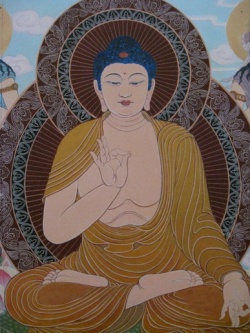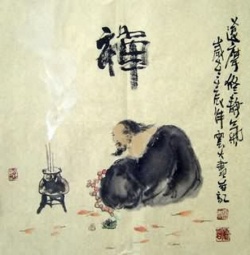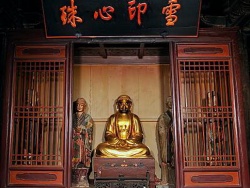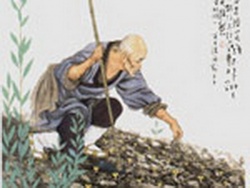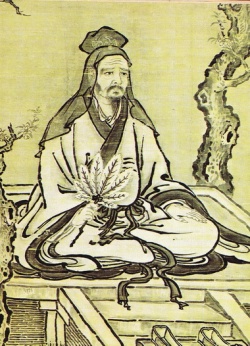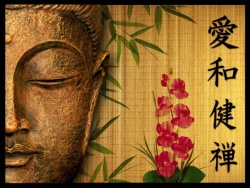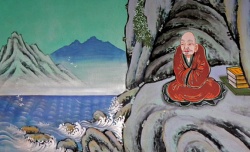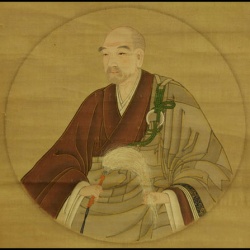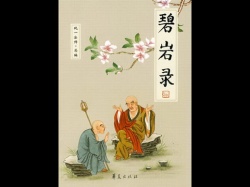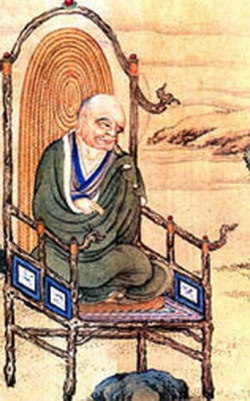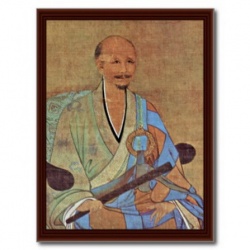The Early Dharma Text Translators
Jump to navigation
Jump to search
The Han Dynasty (25-220 A.D.)
The Period of Three Kingdoms (220-280 A.D.)
The Jin Dynasty (285-420)
- Kashyapamtanga ~25 A.D.
- came from India
- regarded as the first translator for Buddhist sutras in China
- translated 5 sutras, but only 1 extant -- "Sutra of Forty-two Chapters"
- Dharmaraksha ~25 A.D.
- came from India to China and worked with Kashyapamatanga in the translation of sutras.
- An Shih-kao ~170 A.D.
- It was custom in China to take the name of one's birthplace as a surname. "An" was actually not the surname of Shih-kao It simply meant that Shih-kao came from the country called An-hsi
- a prince of Parthia retreated into religion.
- went to China in the Han Dynasty; translated 35 Buddhist scriptures in 41 fascicles in 20 plus years.
- 20 of them are still extant and most of them are Hinayana Buddhist
- Lokakshema 147-185 A.D.
- born in Kushan
- went to China in the Han Dynasty; translated 12 scriptures in 27 fascicles in 40 years.
- 9 scriptures in 20 fascicles are still extant and most of them are Mahayana Buddhist texts such as
- Ashtasahasrika Prajnaparamita Sutra i.e. Perfection of Wisdom Sutra in Eight Thousand Lines, 10 fascicles in 179 .
- Pratyutapnna Buddha Sammukhavasthita Samadhi Sutra - 3 fascicles
- Chu Shih-hsing ~200 A.D.
- went to Khotan and requested the King for the original text of Mahayana sutras.
- translated the sutras in 291 A.D.
- came from Central India to China in the Period of Three Kingdoms.
- proficient in both Hinayana and Mahayana, also Vinaya
- the translation of Vinaya to commence the monastic rules and precepts of Sangha in China.
- came from Samarkand or Soghdiana to China in the Period of Three Kingdoms.
- India monk believed to be of Tibetan descent.
- translation works included
- Larger Sukhavativyuha, The Sutra of Infinite Life 2 fascicles, in 252 .
- came from An-Shih to China during the Period of Three Kingdoms
- translated mainly the Vinaya.
Translators in the Period of Disunity (317-589 A.D.)
- Chih-chien
- Sanghapala / Kang Seng-hui
- Dharmaraksha / Chu Fa-hu
- Gautama Sanghadeva
- Buddhabhadra
- Dharmanandi
- Buddhayashas
- Fa Hsien
- Chu Fo-nein
- Dharmakshema
- Gunabhadra
- Buddhajiva
- Bodhiruchi
- Prajnaruchi
- Chih-chien ~200 A.D.
- Moved from Kushan to China during Dong-wu Dynasty in the Period of Disunity
- translated 88 scriptures for both Hinayana and Mahayana, including
- Atthakavagga, i.e. Meaningful Chapters 2 fascicles in 223-253 .
- Vimalakirti Nirdesha Sutra, i.e. Vimalakirti Sutra 2 fascicles between 223 and 253 A.D.
- Matangi Sutra 2 fascicles
- Sanghapala / Kang Seng-hui ~250
- the eldest son of the Prime Minister of Soghdiana/Samarkand
- immigrated to China during Dong-wu Dynasty in the Period of Disunity
- translated scriptures, included Shatparamita Sangraha Sutra, i.e. Sutra of the Collection of the Practices of the Six Perfections 8 fascicles between 251-280.
- Dharmaraksha / Chu Fa-hu 200-300 A.D.
- from India to China in the Period of Disunity
- ordained in 8 years old, very talented in reading and writing, proficient in 36 languages when he travelled
- known as Tun-huang Bodhisattva
- with a group of 12 translators, he translated 175 scriptures of 354 fascicles, including:
- Avatamsaka Sutra
- Agama Sutra
- Vaipulya Sutras
- Lotus Sutras
- Nirvana Sutra
- Panchavimshati Sahasrika Prajnaparamita Sutra 10 fascicles in 286 .
- Lalitavistara, Detailed Narration of the Sport of the Buddha 8 fascicles in 308
- Ullambana Sutra 1 fascicle.
- Gautama Sanghadeva ~300 A.D.
- from Kabul
- translated 7 scriptures during 383-398 A.D. including
- Madhyama-agama . Middle Length Sayings 60 fascicles in 397-398 .
- Ekottara-agama i.e. Gradual Sayings 51 fascicles 397-398 .
- Treatise of the Heart of Abhidharma
- Buddhabhadra 394-468 .
- from Central India
- invited by Master Hui-yen to stay at Mount Lu to translate sutras
- translated 13 scriptures of 125 fascicles including
- Avatamsaka Sutra in 60 fascicles in 418-421 A.D.
- Mahasanghika Vinaya in 40 fascicles, in 416-418 A.D. jointly with Fa-Hsien
- Yogacarabhum Sutra, i.e. Sutra on the Stages of Yoga Practice (also known as 2 fascicles in 398-421 A.D.
- Mahaparinirvana-suta, i.e. Sutra of the Great Decease , 6 fascicles in 416-418 jointly with Fa-hsien
- Tathagatagarbha Sutra, i.e. Sutra of the Tathagata Treasury 1 fascicle in 420 A.D.
- Madhyama-agama, i.e. Middle Length Sayings in 59 fascicles
- Ekottara-agama, i.e. Gradual Sayingsin 50 fascicles
- the above translated sutras are not extant.
- teacher/advisor of Kumarajiva in Buddhism
- welcomed by the Emperor Yao Hsing of Later Chin Dynasty (when arrived in Chang-an, China)
- translation works including
- Dharmaguptaka Vinaya, i.e. Four-Category Vinaya 60 fascicles in 410-412 A.D.
- Dirgha-agama i.e. Long Sayings 22 fascicles in 412-413 A.D.; jointly with Chu Fo-nien
- Fa Hsien ~422 A.D.
- regarded as the first important Chinese pilgrim
- left China to India in 399 A.D. seeking the original text of Vinaya and other Buddhist scriptures
- returned to China after 15 years bringing many valuable Buddhist scriptures for both Hinayana and Mahayana
- he wrote "Records of the Buddhist Kingdoms" , a documentary to record his travels over 30 countries in India, Sri Lanka, etc.
- translation works including
- Mahaparinirvana Sutra, i.e. Sutra of the Great Decease 6 fascicles in 416-418 A.D., jointly with Buddhabhdra
- Mahasanghika Vinaya, i.e. Vinaya of the Mahasanghika School 40 fascicles in 416-418 A.D., together with Buddhabhadra in translation.
- he was the companion of Buddhayashas in translation works
- there were 12 scriptures in 74 fascicles in his own translation works, including
- Dirgha-agama, i.e. Long Sayings 22 fascicles in 412-413 A.D., jointly with Buddhayashas
- 385-433 A.D.
- from Central India to China during Bei-liang Dynasty during the Period of Disunity
- translated 19 scriptures in 131 fascicles including
- Mahaparinirvana Sutra i.e. Sutra of the Great Decease 40 fascicles in 414-421 A.D., usually taken as the northern version.
- Mahasamnipata Sutra, i.e. Great Collection of Sutras60 fascicles in 414-426 A.D.
- Buddhacarita 5 fascicles
- Bodhisattva Bhumi, i.e. Sutra of a Bodhisattva's Spiritual States 10 fascicles between 414 and 426 A.D.
- Suvanapabhasa Sutra, i.e. Golden Light Sutra 4 fascicles in 414-426 A.D.
- Upasakasila Sutra 7 fascicles.
- Gunabhadra 394-468 A.D.
- moved from Ceylon to China during the Period of Disunity.
- Translated 52 scriptures in 134 fascicles including:
- Samyukta-agama, i.e. Kindred Saying 50 fascicles in 435-443 A.D.
- Lankaratara Sutra, i.e. Sutra of the Appearance of the Good Doctrine in (Sri) Lanka 4 fascicles in 443 A.D.
- Samdhinirmochana Sutra, i.e. Sutra of the Continuation Stream of Emancipation 1 fascicle in 420 A.D.
- Shrimaladevi Simhanada Sutra, i.e. Queen of Shrimala Sutra (the Lion's Roar of Queen Shrimala) 1 fascicle in 436 A.D.
- Buddhajiva ~423 A.D.
- specialized in Vinaya
- Mahishasaka Vinaya, i.e. Five-category Vinaya 30 fascicles
- Paramartha 499-569 A.D.
- from Western India to Southern China during the Period of Disunity
- translated over 50 scriptures in over 120 fascicles including:
- Suvarnaprabhasa Sutra i.e. Golden Light Sutra 7 fascicles in 552 A.D.
- Vajracchedika Prajnaparamita Sutra: Diamond Sutra 1 fascicle in 558-559 A.D.
- Mahayana Shraddhotpada Shastra, i.e. Treatise on the Awaking of Faith in Mahayana 1 fascicle in 553 A.D.
- Mahayanasamgraha i.e. Comprehensive Treatise on Mahayana Buddhism 3 fascicles in 563 A.D.
- Treatise on the Buddha's nature 4 fascicle in 557-569 A.D.
- Saptadasha Bhumika Shastra, i.e. Treatise on the Seventeen Stages of Spiritual Development 5 fascicles
- Abhidharama Kosha Shastra i.e. Abhidharma Storehouse Treatise
- Samdhinirmochana Sutra i.e. Sutra of Emancipation between 557-589 A.D.
- Saddharmapundarikopadesa 2 fascicles.
- Sutra on Neither Increasing nor Deceasing 1 fascicle in 525
